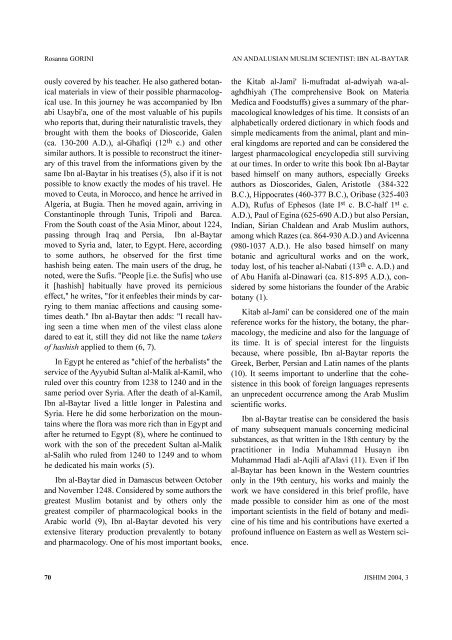Journal - International Society for the History of Islamic Medicine
Journal - International Society for the History of Islamic Medicine
Journal - International Society for the History of Islamic Medicine
Create successful ePaper yourself
Turn your PDF publications into a flip-book with our unique Google optimized e-Paper software.
Rosanna GORINI AN ANDALUSIAN MUSLIM SCIENTIST: IBN AL-BAYTAR<br />
ously covered by his teacher. He also ga<strong>the</strong>red botanical<br />
materials in view <strong>of</strong> <strong>the</strong>ir possible pharmacological<br />
use. In this journey he was accompanied by Ibn<br />
abi Usaybi'a, one <strong>of</strong> <strong>the</strong> most valuable <strong>of</strong> his pupils<br />
who reports that, during <strong>the</strong>ir naturalistic travels, <strong>the</strong>y<br />
brought with <strong>the</strong>m <strong>the</strong> books <strong>of</strong> Dioscoride, Galen<br />
(ca. 130-200 A.D.), al-Ghafiqi (12th c.) and o<strong>the</strong>r<br />
similar authors. It is possible to reconstruct <strong>the</strong> itinerary<br />
<strong>of</strong> this travel from <strong>the</strong> in<strong>for</strong>mations given by <strong>the</strong><br />
same Ibn al-Baytar in his treatises (5), also if it is not<br />
possible to know exactly <strong>the</strong> modes <strong>of</strong> his travel. He<br />
moved to Ceuta, in Morocco, and hence he arrived in<br />
Algeria, at Bugìa. Then he moved again, arriving in<br />
Constantinople through Tunis, Tripoli and Barca.<br />
From <strong>the</strong> South coast <strong>of</strong> <strong>the</strong> Asia Minor, about 1224,<br />
passing through Iraq and Persia, Ibn al-Baytar<br />
moved to Syria and, later, to Egypt. Here, according<br />
to some authors, he observed <strong>for</strong> <strong>the</strong> first time<br />
hashish being eaten. The main users <strong>of</strong> <strong>the</strong> drug, he<br />
noted, were <strong>the</strong> Sufis. "People [i.e. <strong>the</strong> Sufis] who use<br />
it [hashish] habitually have proved its pernicious<br />
effect," he writes, "<strong>for</strong> it enfeebles <strong>the</strong>ir minds by carrying<br />
to <strong>the</strong>m maniac affections and causing sometimes<br />
death." Ibn al-Baytar <strong>the</strong>n adds: "I recall having<br />
seen a time when men <strong>of</strong> <strong>the</strong> vilest class alone<br />
dared to eat it, still <strong>the</strong>y did not like <strong>the</strong> name takers<br />
<strong>of</strong> hashish applied to <strong>the</strong>m (6, 7).<br />
In Egypt he entered as "chief <strong>of</strong> <strong>the</strong> herbalists" <strong>the</strong><br />
service <strong>of</strong> <strong>the</strong> Ayyubid Sultan al-Malik al-Kamil, who<br />
ruled over this country from 1238 to 1240 and in <strong>the</strong><br />
same period over Syria. After <strong>the</strong> death <strong>of</strong> al-Kamil,<br />
Ibn al-Baytar lived a little longer in Palestina and<br />
Syria. Here he did some herborization on <strong>the</strong> mountains<br />
where <strong>the</strong> flora was more rich than in Egypt and<br />
after he returned to Egypt (8), where he continued to<br />
work with <strong>the</strong> son <strong>of</strong> <strong>the</strong> precedent Sultan al-Malik<br />
al-Salih who ruled from 1240 to 1249 and to whom<br />
he dedicated his main works (5).<br />
Ibn al-Baytar died in Damascus between October<br />
and November 1248. Considered by some authors <strong>the</strong><br />
greatest Muslim botanist and by o<strong>the</strong>rs only <strong>the</strong><br />
greatest compiler <strong>of</strong> pharmacological books in <strong>the</strong><br />
Arabic world (9), Ibn al-Baytar devoted his very<br />
extensive literary production prevalently to botany<br />
and pharmacology. One <strong>of</strong> his most important books,<br />
<strong>the</strong> Kitab al-Jami' li-mufradat al-adwiyah wa-alaghdhiyah<br />
(The comprehensive Book on Materia<br />
Medica and Foodstuffs) gives a summary <strong>of</strong> <strong>the</strong> pharmacological<br />
knowledges <strong>of</strong> his time. It consists <strong>of</strong> an<br />
alphabetically ordered dictionary in which foods and<br />
simple medicaments from <strong>the</strong> animal, plant and mineral<br />
kingdoms are reported and can be considered <strong>the</strong><br />
largest pharmacological encyclopedia still surviving<br />
at our times. In order to write this book Ibn al-Baytar<br />
based himself on many authors, especially Greeks<br />
authors as Dioscorides, Galen, Aristotle (384-322<br />
B.C.), Hippocrates (460-377 B.C.), Oribase (325-403<br />
A.D), Rufus <strong>of</strong> Ephesos (late Ist c. B.C-half 1st c.<br />
A.D.), Paul <strong>of</strong> Egina (625-690 A.D.) but also Persian,<br />
Indian, Sirian Chaldean and Arab Muslim authors,<br />
among which Razes (ca. 864-930 A.D.) and Avicenna<br />
(980-1037 A.D.). He also based himself on many<br />
botanic and agricultural works and on <strong>the</strong> work,<br />
today lost, <strong>of</strong> his teacher al-Nabati (13th c. A.D.) and<br />
<strong>of</strong> Abu Hanifa al-Dinawari (ca. 815-895 A.D.), considered<br />
by some historians <strong>the</strong> founder <strong>of</strong> <strong>the</strong> Arabic<br />
botany (1).<br />
Kitab al-Jami' can be considered one <strong>of</strong> <strong>the</strong> main<br />
reference works <strong>for</strong> <strong>the</strong> history, <strong>the</strong> botany, <strong>the</strong> pharmacology,<br />
<strong>the</strong> medicine and also <strong>for</strong> <strong>the</strong> language <strong>of</strong><br />
its time. It is <strong>of</strong> special interest <strong>for</strong> <strong>the</strong> linguists<br />
because, where possible, Ibn al-Baytar reports <strong>the</strong><br />
Greek, Berber, Persian and Latin names <strong>of</strong> <strong>the</strong> plants<br />
(10). It seems important to underline that <strong>the</strong> cohesistence<br />
in this book <strong>of</strong> <strong>for</strong>eign languages represents<br />
an unprecedent occurrence among <strong>the</strong> Arab Muslim<br />
scientific works.<br />
Ibn al-Baytar treatise can be considered <strong>the</strong> basis<br />
<strong>of</strong> many subsequent manuals concerning medicinal<br />
substances, as that written in <strong>the</strong> 18th century by <strong>the</strong><br />
practitioner in India Muhammad Husayn ibn<br />
Muhammad Hadi al-Aqili al'Alavi (11). Even if Ibn<br />
al-Baytar has been known in <strong>the</strong> Western countries<br />
only in <strong>the</strong> 19th century, his works and mainly <strong>the</strong><br />
work we have considered in this brief pr<strong>of</strong>ile, have<br />
made possible to consider him as one <strong>of</strong> <strong>the</strong> most<br />
important scientists in <strong>the</strong> field <strong>of</strong> botany and medicine<br />
<strong>of</strong> his time and his contributions have exerted a<br />
pr<strong>of</strong>ound influence on Eastern as well as Western science.<br />
70 JISHIM 2004, 3

















